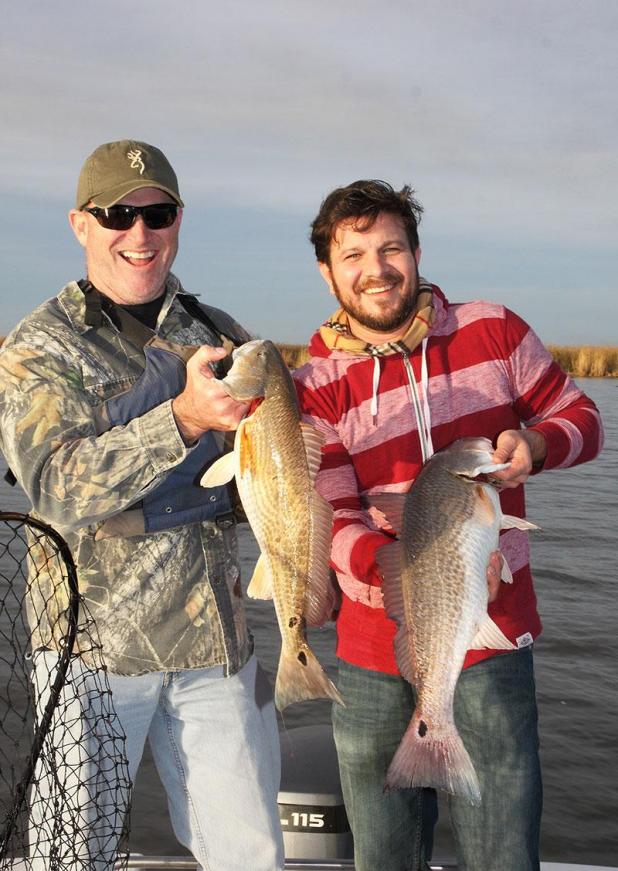
The Daily Review Outdoor Writer John Flores' son-in-law Charles Coak and son Jason Flores pose with a couple of good winter red fish caught at Humble Canal in East Cote Blanche Bay. (Submitted Photo/Courtesy of John K. Flores)
Time to take advantage of the winter transition
Seventy- and 80-degree highs to mid-40s during the last few days is bound to have had an impact on fishing in the coastal marsh. Welcome to the winter transition, folks. It’s a time when many anglers park their bay boats until next spring.
But, there are those like Ken Chaumont, owner/president of Egret Baits, who says fishing actually can be easier at this time of year.
“In the wintertime, the shrimp are gone,” Chaumont said. “So, as the shrimp disappear, all the trout, reds and flounder have to eat fish. They’re going to eat shad, pogie, mullet and croaker, so it turns into a hunt for bait. And, what happens is the bait will seek a perfect temperature. Anywhere from 16 to 20 feet deep seems to be the area where the bait balls just rack up. That’s when the bonanza takes place. The fish gorge, knowing they have to fatten up. They’re gorging on any bait that runs in the deeper channels and bayous.”
Essentially, as winter sets in, fishing takes on a different dynamic, according to Chaumont. All of a sudden, the fish are staying in deeper water. The fish are going to find the thermocline in order to get comfortable. When they do get comfortable in that optimal temperature, they suspend.
When these gamefish do start eating and gorging themselves, it may be limited to a once-a-day feeding. Saltwater anglers want to look for shallow water shelves or ledges near deep water drop offs where the shad bait balls suspend.
The shallow water shelves and ledges are often wide flats that may be only 4 to 7 feet deep. But if they’re near the 16 to 20-feet deep channels and the bait is there hanging along the edge near the shallows, fishermen stand a good chance of catching.
Tip No. 1 for winter anglers might be: “It’s okay to be in and fish the shallow flats but be very close or have good access to the deeper water.”
Remember, during the next several weeks as more and more cold fronts pass through our region, they will push the bait and the gamefish, chasing it deeper into the thermocline.
Besides deeper channels and bayous, be sure to not overlook deep water canals in the winter months, too. Water in the back of deep canals tends to be warmer by a few to several degrees compared to its opening.
Tip No. 2 is: After several days of cold temperatures where it increases suddenly to 75-degree days, you’ll want to be fishing the shallows. Quite often, as soon as the sun warms, the shallows some of the bait will move right back into this depth. I’ve kayaked fished in the Port of Fourchon after one of these fronts and caught redfish in the mangrove shallows.
When it comes to best baits during the winter transition period, Chaumont’s Egret Baits are hard to beat. One bait that comes to mind is the Zombie Rip Stik. This three-inch crankbait actually suspends beneath the surface and when retrieved, runs a little deeper. Fishing just off the ledges where it meets the deeper drop off is a deadly technique.
Another crank-type bait is the “Rat-L-Trap.” Rip Stiks and Rattle-L-Traps with black or dark purple backs, with silver, pearl or white sides and belly resemble shad.
Other baits that work during the winter transition are soft plastics. Egret Wedgetails, H&H Cocahoe Minnows and D.O.A. Bait Busters are all good choices.
“Once the fish move way out, we start throwing things like 3-1/2” Wedgetails on ¼” jig heads,” Chaumont said. “Working a jig head with a plastic attached on deep drop offs is an excellent technique during the winter. I’ve seen other guys throwing popping corks with the bait not 18 inches from the cork, like you usually see, but 4 to 5 feet. They work that rig across the ledges of drop offs, and it’s very effective.”
Other winter weather includes fronts with heavy rains to which Chaumont said if the front is a heavy flush, stay home. But, he added, if it’s a wind event with some rain where the water gets a little muddy or sandy, remember, salt is heavier than water.
“What I normally do in those conditions is go to dark colors because you want contrast,” Chaumont said. “You can still go to those deep channels, because salt is heavier than freshwater. You might have three feet of freshwater on top of saltwater. And, I’m talking very deep water, sometimes 35 to 45 feet, like in deep ship channels.”
Winter transition tip No. 3: Saltwater is heavier than freshwater.
Last Christmas after eating way too much and feeling like a slug on the couch watching football, I rounded up my sons and hooked up my bay boat. We took off for an afternoon trip out of Burns Point and headed to the Humble Canal in East Cote Blanche Bay.
We only had a couple of hours of daylight, so we anchored out at the mouth of the canal in deep water. Using both dead shrimp and plastics on jigs, we managed to catch several good redfish. Not limits by any stretch but enough to make the afternoon a huge success.
The winter transition doesn’t mean you have to hibernate. It just means you may have to think a little differently than during the summer months. And, you just might catch enough fish to make it worth your while.
EDITOR’S NOTE: Flores is The Daily Review’s Outdoor Columnist. If you wish to make a comment or have an anecdote, recipe or story to share, contact Flores at 985-395-5586 or at gowiththeflo@cox.net.
